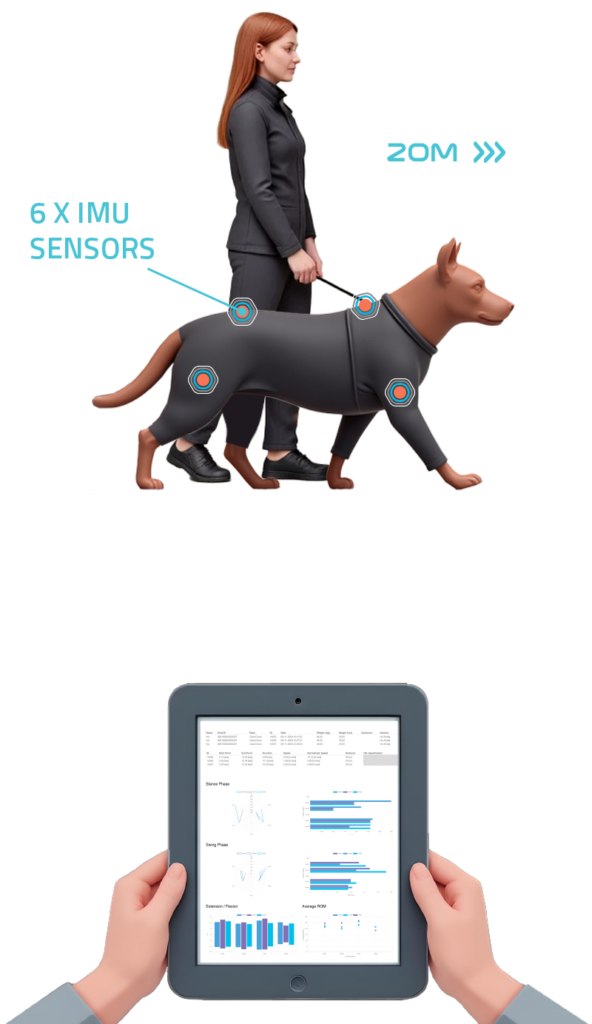How gait analysis helps to identify orthopaedic problems in dogs at an early stage
Measure movement patterns, detect lameness at an early stage
Why is gait analysis essential in dogs?
Gait analysis in dogs is a key diagnostic tool for detecting movement disorders at an early stage. Orthopaedic or neurological abnormalities are often difficult to identify in their initial phases because dogs instinctively compensate for pain. While obvious lameness is visible to the human eye, subtle gait abnormalities frequently go unnoticed. A precise gait analysis provides objective measurements, helping to diagnose and treat joint diseases, incorrect loading, or neurological disorders in time.
While traditional clinical examinations rely primarily on subjective assessments, a scientifically based gait analysis delivers accurate movement measurements and load distributions. This objective approach allows for the early identification of musculoskeletal disorders and the development of tailored treatment strategies. As a result, gait analysis plays a particularly important role in diagnosing orthopaedic and neurological diseases.
Fundamentals of gait analysis
Kinematics and kinetics in motion research
Modern gait analysis in veterinary medicine is based on two central scientific disciplines: Firstly, kinematics examines the spatial and temporal aspects of movement, including stride length, joint angles, stride frequency, and gait phases. This method is particularly valuable for evaluating lameness and compensation mechanisms. Secondly, kinetics provides insights into load distribution, ground reaction forces, and muscle activity. This allows for the identification of incorrect loading patterns, which often result from compensatory postures or pain. By combining kinematic and kinetic analyses, gait analysis enables a comprehensive assessment of the dog’s movement patterns. As a result, subtle abnormalities, which are often invisible to the naked eye, can be detected at an early stage.
Kinetic analysis, on the other hand, provides information on load distribution, ground reaction forces and muscle activity. This allows incorrect loading to be identified, for example due to relieving postures or pain. Together, these two methods enable a detailed examination of the gait pattern, revealing subtle changes that are often invisible to the naked eye.

Areas of application for gait analysis in veterinary medicine
Gait analysis is used today in various areas of veterinary medicine to analyze movement patterns and develop targeted measures for therapy and prevention. It offers a decisive advantage, particularly in the early detection of orthopaedic diseases such as hip dysplasia or elbow dysplasia. The first signs of these diseases can be detected at a young age, enabling early intervention.
Gait analysis has also established itself as a valuable tool in rehabilitation medicine. After orthopaedic operations or injuries, it helps to objectively document the healing process and adapt the therapy individually. This allows progress to be measured and undesirable developments to be corrected in good time.
Another important area of application is pain diagnostics. Chronic pain in dogs often manifests itself in altered movement patterns, which can be precisely mapped using gait analysis. As dogs are often very good at compensating for pain, a detailed analysis can help to identify this at an early stage and provide targeted treatment.
The role of modern sensor technology in gait analysis
Traditionally, the assessment of a dog’s gait was based on the examiner’s visual assessment. However, modern sensor technologies such as IMU sensors (Inertial Measurement Units) now make it possible to record movements objectively and reproducibly. These sensors measure the acceleration, rotation and orientation of the body and thus provide highly precise data on the dog’s gait.
With the help of such technologies, gait parameters such as stride length, joint angle changes and weight shifts can be precisely quantified. This enables an exact diagnosis and well-founded therapy planning based on objective measured values. This is a great advantage for vets and physiotherapists in particular, as they no longer have to rely solely on their subjective observations.
Gait analysis in dogs as the key to better orthopaedic care
The importance of gait analysis for modern veterinary medicine can hardly be overestimated. It enables early detection of orthopaedic and neurological diseases, objective progress monitoring during rehabilitation and targeted pain diagnostics. By making movement patterns measurable, it helps to sustainably improve the quality of treatment.
While gait analysis is already standard in human medicine, it is also becoming increasingly important in veterinary medicine. Innovative systems such as LupoGait make it possible to integrate this valuable diagnostic tool efficiently and practically into everyday clinical practice. This benefits not only vets, but above all the dogs themselves – because the earlier abnormalities are detected, the better they can be treated.
Learn more:
Learn more about the technology behind LupoGait